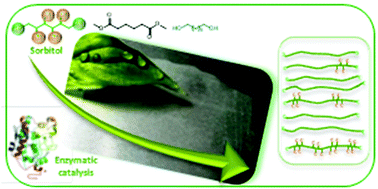Sustainable coatings from bio-based, enzymatically synthesized polyesters with enhanced functionalities†
Abstract
Bio-based sorbitol-containing polyester polyols were synthesized via enzymatic polycondensation. The selectivity of the biocatalyst for primary vs. secondary hydroxyl groups allowed for the preparation of close to linear renewable polyester polyols with enhanced hydroxyl functionalities, both as pendant groups and end-groups. In some cases, the sorbitol units were homogeneously distributed in the polyester polyol chains, whereas changes in the comonomers used and experimental conditions led to inhomogeneous and unique distributions of sorbitol, implying that some polyester polyol chains contained none and others contained multiple sorbitol units. Solvent-borne coatings were prepared by cross-linking the functional polyester polyols with polyisocyanate curing agents. An increased functionality of the polyester polyols led to an enhancement of the properties of the resulting cured coatings. Furthermore, when sorbitol units were non-homogeneously distributed, a significant improvement in the chemical resistance and mechanical properties of the cured poly(ester urethane) network was noted. By employing the bio-based diisocyanate EELDI (ethyl ester L-lysine diisocyanate) as a curing agent, almost fully renewable coatings with satisfactory mechanical properties were obtained.


 Please wait while we load your content...
Please wait while we load your content...